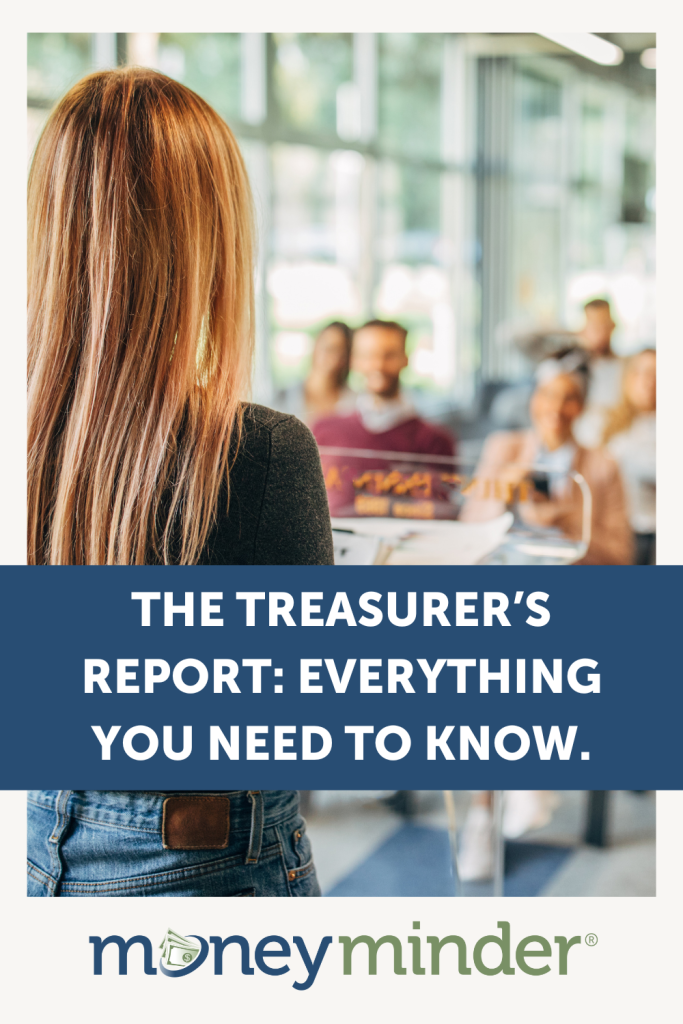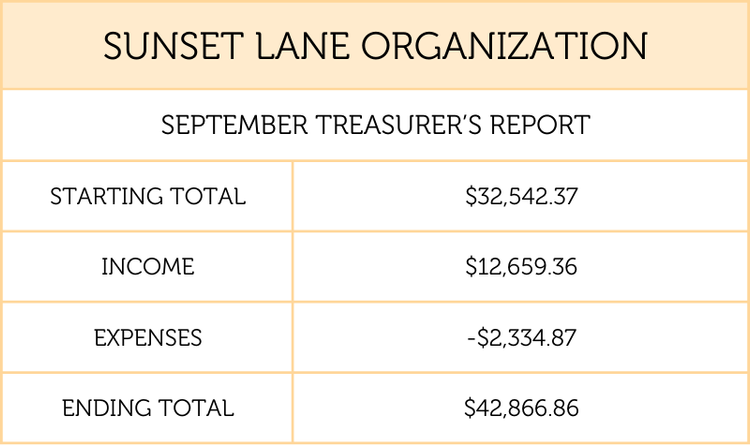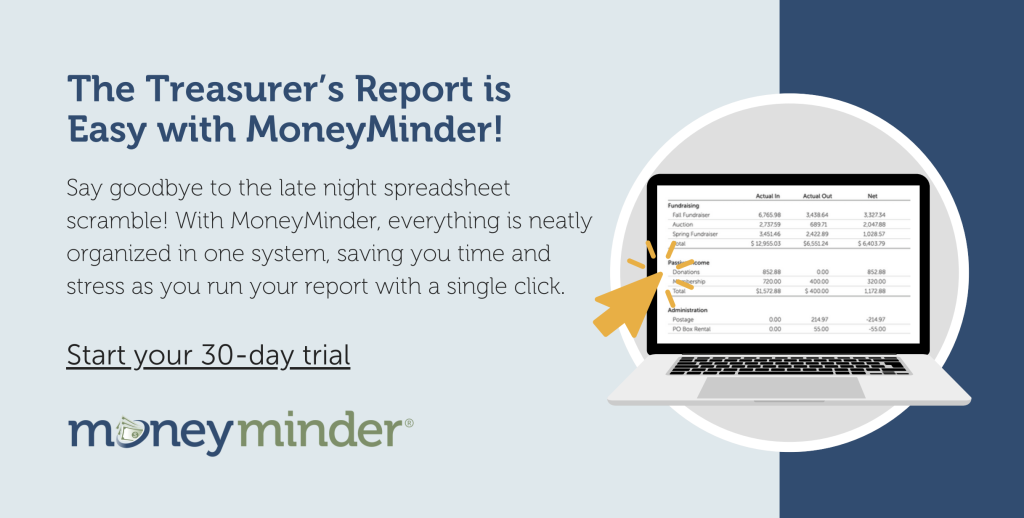The Treasurer’s Report is a critical document for any nonprofit, no matter the size. Many large nonprofits have an accountant they may work with to generate this report. But for smaller nonprofits — booster clubs, PTOs, PTAs, sports teams, charities, associations, clubs and more — it’s a volunteer treasurer that is compiling and presenting the report.
Is that you? It’s in important job. Your group needs that to provide a clear and concise overview of the organization’s health. This report is conducted monthly and annually to help board members and other stakeholders make informed decisions and ensure accountability.
So, if you’re the treasurer who’s been tasked with creating and presenting this report, fear not. We’ll cover everything you need to know about the treasurer’s report.
What is the Purpose of the Treasurer’s Report?

The primary purpose of the treasurer’s report is to provide transparency and accountability into your organization’s finances. It serves as a tool for:
- Informing stakeholders: board members, members and other parties can use this information to understand your group’s current financial position.
- Evaluating performance: the state of your finances can then be compared to your budget to identify areas for change or improvement.
- Making informed decisions: that information can then be used to make changes, allocate resources differently or adjust fundraisers.
- Ensuring compliance: some groups’ bylaws require the treasurer’s report.
Monthly vs. Annual Treasurer’s Reports
It is recommended that the treasurer’s report is run and shared on a monthly and annual basis. While the core elements of these reports is the same, monthly reports often provide a more granular view of the finances, focused on recent transactions and trends.
The annual treasurer’s report offers a broader perspective, summarizing your financial performance over the entire year. It is customary for the treasurer to complete the annual report before his or her term ends. As mentioned, some groups (such as the National PTA) require this as a part of year-end reporting.
Sections of a Nonprofit Treasurer’s Report

Monthly Treasurer’s Report Sections
- Name of your organization
- Dates the report covers
- Bank balance(s) at the beginning of the period
- Total income for the period
- Total expenses for the period
- Balance(s) at the end of the period
Annual Treasurer’s Report Sections
- Name of your organization
- Dates the report covers
- Balance carried forward from last year (“starting total”)
- Income for the year
- Expenses for the year
- Balance at the end of the year to carry forward to next year (“ending total”)
- Your name and signature
- Date the report was prepared

How Much Detail Should the Treasurer Provide?
The MoneyMinder Treasurer Report includes the summary information detailed above. It is our stance that this high level information is all that non-treasurers need to understand your financial position without becoming overwhelmed. You also don’t want to derail your meetings by getting into the weeds with too much detail.
However, every group is different. If your group requires more detailed reports at meetings, you could try the All Transactions by Category or All Transactions by Heading and Category reports in MoneyMinder. At the very least, you could have these prepared in order to answer questions, rather than handing them out and potentially opening a can of worms with people wanting to understand every nuance. You can always invite people to talk afterwards if there are specific questions.
How to Store Your Group’s Report
While it’s nice to pass out physical copies of your report, there’s usually no need to keep these physical copies beyond the meeting. You should, however, have a way to store your treasurer’s report digitally. Use a secure cloud storage platform like Google Drive to store them digitally. MoneyMinder users can also use the documents section to store reports at no extra cost beyond the annual subscription fee.
Giving the Treasurer’s Report at Your Board Meeting
Now that you’ve prepared your treasurer’s report, it’s time to present it in your next board meeting. We suggest sharing the report with your board a few days in advance so they may have time to review it. We also like handing out physical copies at the meeting, but we understand the desire to go green might supersede this suggestion.
Present your treasurer’s report on the big screen if possible, and point out your opening balance, income, expenses and ending balance for the time period you are covering. You should do this once for each bank account. Be prepared to provide additional context and answer any questions that arise. But if you don’t know the answer, you can always investigate and report back.
Are you finding all you get is blank stares? Check out our podcast on making your treasurer’s report more exciting.
Feeling Nervous About Giving the Treasurer’s Report? You’re Not Alone.
At the time of this writing, 3,312 people have downloaded MoneyMinder guides on giving the treasurer’s report. So, yeah, you’re not the only one who is a bit apprehensive. For parent and school based groups, we have the PTO/PTA Treasurer’s Report Guide. For all other group types, the Treasurer’s Report Guide will come in handy.
Feel more confident and prepared with a comprehensive guide that includes a step-by-step guide, a sample treasurer’s report, and a written and oral script.

 Connect your Venmo account to MoneyMinder PRO to directly download transactions, saving you time and effort. You just review the transactions to ensure they are properly categorized and fill out any required fields.
Connect your Venmo account to MoneyMinder PRO to directly download transactions, saving you time and effort. You just review the transactions to ensure they are properly categorized and fill out any required fields. Connect your Bank, Square and PayPal accounts to MoneyMinder PRO to directly download transactions, saving you time and effort. You just review the transactions to ensure they are properly categorized and fill out any required fields.
Connect your Bank, Square and PayPal accounts to MoneyMinder PRO to directly download transactions, saving you time and effort. You just review the transactions to ensure they are properly categorized and fill out any required fields. Connect your Bank, Paypal and Square accounts to MoneyMinder PRO to directly download transactions, saving you time and effort. You just review the transactions to ensure they are properly categorized and fill out any required fields.
Connect your Bank, Paypal and Square accounts to MoneyMinder PRO to directly download transactions, saving you time and effort. You just review the transactions to ensure they are properly categorized and fill out any required fields. Connect your Bank, Paypal and Square accounts to MoneyMinder PRO to directly download transactions, saving you time and effort. You just review the transactions to ensure they are properly categorized and fill out any required fields.
Connect your Bank, Paypal and Square accounts to MoneyMinder PRO to directly download transactions, saving you time and effort. You just review the transactions to ensure they are properly categorized and fill out any required fields. Join It is a membership management service that helps businesses and nonprofits effectively sell, track, and grow their membership.
Join It is a membership management service that helps businesses and nonprofits effectively sell, track, and grow their membership.